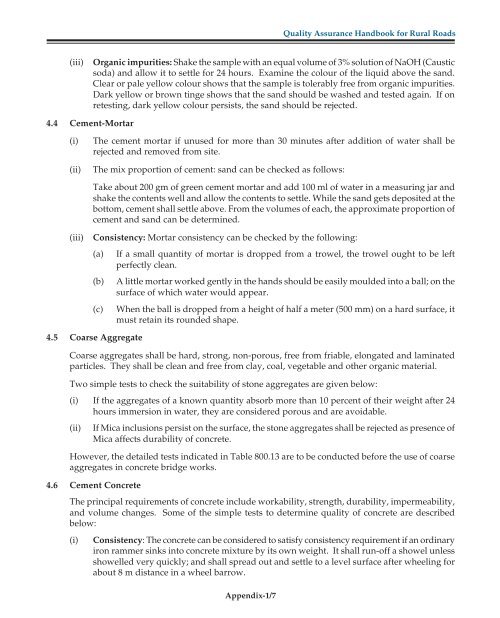Quality Assurance Handbook for Rural Roads Volume-I - pmgsy
Quality Assurance Handbook for Rural Roads Volume-I - pmgsy
Quality Assurance Handbook for Rural Roads Volume-I - pmgsy
Create successful ePaper yourself
Turn your PDF publications into a flip-book with our unique Google optimized e-Paper software.
<strong>Quality</strong> <strong>Assurance</strong> <strong>Handbook</strong> <strong>for</strong> <strong>Rural</strong> <strong>Roads</strong><br />
(iii) Organic impurities: Shake the sample with an equal volume of 3% solution of NaOH (Caustic<br />
soda) and allow it to settle <strong>for</strong> 24 hours. Examine the colour of the liquid above the sand.<br />
Clear or pale yellow colour shows that the sample is tolerably free from organic impurities.<br />
Dark yellow or brown tinge shows that the sand should be washed and tested again. If on<br />
retesting, dark yellow colour persists, the sand should be rejected.<br />
4.4 Cement-Mortar<br />
(i) The cement mortar if unused <strong>for</strong> more than 30 minutes after addition of water shall be<br />
rejected and removed from site.<br />
(ii) The mix proportion of cement: sand can be checked as follows:<br />
Take about 200 gm of green cement mortar and add 100 ml of water in a measuring jar and<br />
shake the contents well and allow the contents to settle. While the sand gets deposited at the<br />
bottom, cement shall settle above. From the volumes of each, the approximate proportion of<br />
cement and sand can be determined.<br />
(iii) Consistency: Mortar consistency can be checked by the following:<br />
(a) If a small quantity of mortar is dropped from a trowel, the trowel ought to be left<br />
perfectly clean.<br />
(b) A little mortar worked gently in the hands should be easily moulded into a ball; on the<br />
surface of which water would appear.<br />
(c) When the ball is dropped from a height of half a meter (500 mm) on a hard surface, it<br />
must retain its rounded shape.<br />
4.5 Coarse Aggregate<br />
Coarse aggregates shall be hard, strong, non-porous, free from friable, elongated and laminated<br />
particles. They shall be clean and free from clay, coal, vegetable and other organic material.<br />
Two simple tests to check the suitability of stone aggregates are given below:<br />
(i) If the aggregates of a known quantity absorb more than 10 percent of their weight after 24<br />
hours immersion in water, they are considered porous and are avoidable.<br />
(ii) If Mica inclusions persist on the surface, the stone aggregates shall be rejected as presence of<br />
Mica affects durability of concrete.<br />
However, the detailed tests indicated in Table 800.13 are to be conducted be<strong>for</strong>e the use of coarse<br />
aggregates in concrete bridge works.<br />
4.6 Cement Concrete<br />
The principal requirements of concrete include workability, strength, durability, impermeability,<br />
and volume changes. Some of the simple tests to determine quality of concrete are described<br />
below:<br />
(i) Consistency: The concrete can be considered to satisfy consistency requirement if an ordinary<br />
iron rammer sinks into concrete mixture by its own weight. It shall run-off a showel unless<br />
showelled very quickly; and shall spread out and settle to a level surface after wheeling <strong>for</strong><br />
about 8 m distance in a wheel barrow.<br />
Appendix-1/7
















